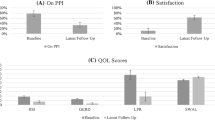Abstract
Introduction
Chronic anemia is a common, coinciding or presenting diagnosis in patients with paraesophageal hernia (PEH). Presence of endoscopically identified ulcerations frequently prompts surgical consultation in the otherwise asymptomatic patient with anemia. Rates of anemia resolution following paraesophageal hernia repair (PEHR) often exceed the prevalence of such lesions in the study population. A defined algorithm remains elusive. This study aims to characterize resolution of anemia after PEHR with respect to endoscopic diagnosis.
Materials and methods
Retrospective review of a prospectively maintained database of patients with PEH and anemia undergoing PEHR from 2007 to 2018 was performed. Anemia was determined by preoperative labs: Hgb < 12 mg/dl in females, Hgb < 13 mg/dl in males, or patients with ongoing iron supplementation. Improvement of post-operative anemia was assessed by post-operative hemoglobin values and continued necessity of iron supplementation.
Results
Among 56 identified patients, 45 were female (80.4%). Forty patients (71.4%) were anemic by hemoglobin value, 16 patients (28.6%) required iron supplementation. Mean age was 65.1 years, with mean BMI of 27.7 kg/m2. One case was a Type IV PEH and the rest Type III. 32 (64.0%) had potential source of anemia: 16 (32.0%) Cameron lesions, 6 (12.0%) gastric ulcers, 12 (24.0%) gastritis. 10 (20.0%) had esophagitis and 4 (8%) Barrett’s esophagus. 18 (36%) PEH patients had normal preoperative EGD. Median follow-up was 160 days. Anemia resolution occurred in 46.4% of patients. Of the 16 patients with pre-procedure Cameron lesions, 10 (63%) had resolution of anemia. Patients with esophagitis did not achieve resolution. 72.2% (13/18) of patients with no lesions on EGD had anemia resolution (p = 0.03).
Conclusion
Patients with PEH and identifiable ulcerations showed 50% resolution of anemia after hernia repair. Patients without identifiable lesions on endoscopy demonstrated statistically significant resolution of anemia in 72.2% of cases. Anemia associated with PEH adds an indication for surgical repair with curative intent.
Similar content being viewed by others
References
Dangleben DA, Du C (2017) Paraesophageal hernia. Acute Care Gen Surg 95(3):101–106. https://doi.org/10.1016/j.suc.2015.02.008
Haurani C, Carlin AM, Hammoud ZT, Velanovich V (2012) Prevalence and resolution of anemia with paraesophageal hernia repair. J Gastrointest Surg 16(10):1817–1820
Fiorini G, Lahner E, Annibale B, Zullo A, De Francesco V, Vaira D et al (2018) Cameron lesions: a still overlooked diagnosis Case report and systematic review of literature. Clin Res Hepatol Gastroenterol 42(6):604–609. https://doi.org/10.1016/j.clinre.2018.05.002
Wideman TH, Zautra AJ, Edwards RR (2014) Re-thinking the fear avoidance model: toward a multi-dimensional framework of pain-related disability. NIH Public Access 154(11):2262–2265
Maganty K, Smith RL (2008) Cameron lesions: unusual cause of gastrointestinal bleeding and anemia. Digestion 77(3–4):214–217
Carrott PW, Hong J, Kuppusamy M, Koehler RP, Low DE (2012) Clinical ramifications of giant paraesophageal hernias are underappreciated: Making the case for routine surgical repair. Ann Thorac Surg 94(2):421–428. https://doi.org/10.1016/j.athoracsur.2012.04.058
Velanovich V, Karmy-Jones R (2003) Surgical Management of paraesophageal hernias: outcome and quality of life analysis/with invited commentary. Dig Surg 18(6):432–438
Skipworth RJE, Staerkle RF, Leibman S, Smith GS (2014) Transfusion-dependent anaemia: an overlooked complication of paraoesophageal hernias. Int Sch Res Not 2014:1–4
Hayden H, Jamieson J (2005) Diseases of the esophagus effect on iron deficiency anemia of laparoscopic repair of large paraesophageal hernias. Dis Esophagus 18(5):329–331
Ruhl CE, Everhart JE (2001) Relationship of iron-deficiency anemia with esophagitis and hiatal hernia: hospital findings from a prospective, population-based study. Am J Gastroenterol 96(2):322–326
Windsor CW, Collis JL (1967) Anaemia and hiatus hernia: experience in 450 patients. Thorax 22(1):73–78
Carrott PW, Markar SR, Hong J, Kuppusamy MK, Koehler RP, Low DE (2013) Iron-deficiency anemia is a common presenting issue with giant paraesophageal hernia and resolves following repair. J Gastrointest Surg 17(5):858–862
Eubanks TR, Pellegrini CA, Jacobsen G, Horgan S, Omelanczuk P (2002) Repair of paraesophageal hernias. Am J Surg 177(5):354–358
Trastek VF, Allen MS, Deschamps C, Pairolero PC, Thompson A, Altorki N (1996) Diaphragmatic hernia and associated anemia: response to surgical treatment. J Thorac Cardiovasc Surg 112(5):1340–1345
Chevrollier GS, Brown AM, Keith SW, Szewczyk J, Pucci MJ, Chojnacki KA et al (2019) Preoperative anemia: a common finding that predicts worse outcomes in patients undergoing primary hiatal hernia repair. Surg Endosc. 33(2):535–542. https://doi.org/10.1007/s00464-018-6328-4
Zuckerman GR, Prakash C, Askin MP, Lewis BS (2000) AGA technical review on the evaluation and management of occult and obscure gastrointestinal bleeding. Gastroenterology 118(1):201–221
Delle Fave G, Annibale B, Di Giulio E, Capurso G, Baccini F, Panzuto F et al (2004) Large hiatal hernia in patients with iron deficiency anaemia: a prospective study on prevalence and treatment. Aliment Pharmacol Ther 19(6):663–670
El Khoury R, Ramirez M, Hungness ES, Soper NJ, Patti MG (2015) Symptom relief after laparoscopic paraesophageal hernia repair without mesh. J Gastrointest Surg 19(11):1938–1942
D’Ambra G, Fave GD, Lahner E, Capurso G, Di Giulio E, Annibale B et al (2003) Role of small bowel investigation in iron deficiency anaemia after negative endoscopic/histologic evaluation of the upper and lower gastrointestinal tract. Dig Liver Dis 35(11):784–787
Karmali S, McFadden S, Mitchell P, Graham A, Debru E, Gelfand G et al (2008) Primary laparoscopic and open repair of paraesophageal hernias: a comparison of short-term outcomes. Dis Esophagus 21(1):63–68
Hinojosa MW, Reavis KM, Parikh D, Varela E, Nguyen NT (2012) Utilization and outcomes of laparoscopic versus open paraesophageal hernia repair. Am Surg 2014:90035
Author information
Authors and Affiliations
Corresponding author
Ethics declarations
Disclosures
Dr. Horgan has stock options with TORAX™ Medical Inc. Dr. Jacobsen has two grants with TORAX™ Medical Inc, the first for The CALIBER Study: Randomized Controlled Trial of LINX versus Double-Dose Proton Pump Inhibitor Therapy for Reflux Disease, and the second for A Post-Approval Study of the LINX®Reflux management system. Drs. Cheverie, Broderick, Lam, Lee, Neki, Matsuzaki, Cubas, Sandler, and Fuchs have no conflicts of interest or financial ties to disclose.
Additional information
Publisher's Note
Springer Nature remains neutral with regard to jurisdictional claims in published maps and institutional affiliations.
Rights and permissions
About this article
Cite this article
Cheverie, J.N., Lam, J., Neki, K. et al. Paraesophageal hernia repair: a curative consideration for chronic anemia?. Surg Endosc 34, 2243–2247 (2020). https://doi.org/10.1007/s00464-019-07014-3
Received:
Accepted:
Published:
Issue Date:
DOI: https://doi.org/10.1007/s00464-019-07014-3




